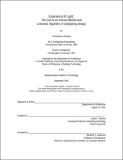| dc.contributor.advisor | Leslie K. Norford. | en_US |
| dc.contributor.author | Chutarat, Acharawan | en_US |
| dc.contributor.other | Massachusetts Institute of Technology. Dept. of Architecture. | en_US |
| dc.date.accessioned | 2005-05-19T14:32:57Z | |
| dc.date.available | 2005-05-19T14:32:57Z | |
| dc.date.copyright | 2001 | en_US |
| dc.date.issued | 2001 | en_US |
| dc.identifier.uri | http://hdl.handle.net/1721.1/16775 | |
| dc.description | Thesis (Ph. D.)--Massachusetts Institute of Technology, Dept. of Architecture, 2001. | en_US |
| dc.description | Includes bibliographical references (p. 145-147). | en_US |
| dc.description | This electronic version was submitted by the student author. The certified thesis is available in the Institute Archives and Special Collections. | en_US |
| dc.description.abstract | Integration of daylight availability in time and architectural space is a critical element in achieving optimal comfort and productivity, as well as in minimizing energy consumption. In recent years, there has been an increase in the demand of the better quality of the built environment. Accessibility and availability of information do not assurance success in design. There is a gap between available information and design team. A critical understanding of the issues that affects design and its process needs to be developed. Successful strategies require the participation of individual users and designers in configuring built environments and needs. Before proposing a new solution, success factors and methodology have been identified. There are many problems-solving techniques associated with design and delivery systems. Most popular techniques are forward methods and typically employed "trial and error" processes, attacking problems on the front end first. On the other hand, a problem-solving technique called the inverse method seems to be efficient. It starts with designer's goals and then identifies a design to meet those goals. In an effort to provide optimum choices in daylighting design, this thesis emphasizes the use of scientific-knowledge computational tools in the later stages of design employing the inverse method. The genetic algorithm (GA) is applied to search for optimal daylighting design strategies. A new design process has been created, developed, and implemented to increase design process efficiency and creativity. This thesis additionally presents a structured method for defining and evaluating multiple objectives. Objective measures are defined as maximized visual comfort and preferred lighting conditions. The thesis introduces a new daylight glare index (DGln). Further, a study has been conducted comparing subjective glare response in an office space with the DGln. Its correlation yields very promising results. Moreover, this research investigates several design problems, GA parameters, and processes for improving design results and efficiency. The most important aspect of GA and its application is the use of computation not as an analytical tool but rather as a vehicle to stimulate learning in the design process. Finally, ideas are presented for future work, based on the potential suggested by our findings. | en_US |
| dc.description.statementofresponsibility | by Acharawan Chutarat. | en_US |
| dc.format.extent | 211 p. | en_US |
| dc.format.extent | 4561916 bytes | |
| dc.format.extent | 4561674 bytes | |
| dc.format.mimetype | application/pdf | |
| dc.format.mimetype | application/pdf | |
| dc.language.iso | eng | en_US |
| dc.publisher | Massachusetts Institute of Technology | en_US |
| dc.rights | M.I.T. theses are protected by copyright. They may be viewed from this source for any purpose, but reproduction or distribution in any format is prohibited without written permission. See provided URL for inquiries about permission. | en_US |
| dc.rights.uri | http://dspace.mit.edu/handle/1721.1/7582 | |
| dc.subject | Architecture. | en_US |
| dc.title | Experience of light : the use of an inverse method and a genetic algorithm in daylight design | en_US |
| dc.type | Thesis | en_US |
| dc.description.degree | Ph.D. | en_US |
| dc.contributor.department | Massachusetts Institute of Technology. Department of Architecture | |
| dc.identifier.oclc | 49280417 | en_US |

